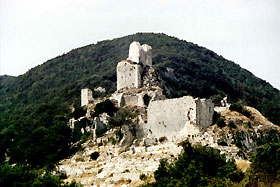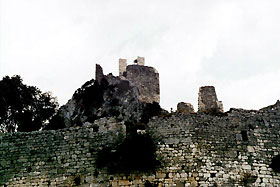Rocca of S.Silvestro
 |
 |
| The top of the hill where Rocca San Silvestro rises: we can still notice the ruins of the keep, the palace, the chapel and the walled enclosure. | |
Photos by Moreno Macii
Rocca S.Silvestro can be reached, either from south that from north, following the the SS1 Aurelia towards Campiglia Marittima, from which its around 3 kilometers far. The site rises to the slopes of the Mount Baldo to the center of an archaeological park accessible only with guided tours.
Click here for More Photos
The strengthened village of Rocca S.Silvestro, known during the whole Middle Age with the name of Rocca Palmento, was then first of the principal installations of the Tuscan Diocese of Populonia and then of Massa Marittima, thanks to its position on a rocky spur dominating the coastline lowland, marshy at the time, between the gulf of Baratti and the Metallifere Hills. More than military its importance was tied to the extractive activity, in fact great part of the area of the suburb was destined to the transformation of the argent, copper and lead of which the underground was rich since the times of the Etruscan.
The castle had its origin between the 10th and 11th century when the counts of the Gherardesca decided to exploit the mining resources of the zone and are of this period the first traces of fortifications: the residence of the gentlemen was at the vertex of the inhabited area, almost an 'acropoli' defended by a walled enclosure at the time still deprived of keep, while the rest of the suburb was encircled by an ulterior curtain of stone. With the decline of the Gherardesca family and the take over of the Della Rocca as gentlemen of the castle at the beginnings of the 12th century, Rocca S.Silvestro had a strong economic and urbanism growth. The town walls were rebuilt and gifted of a fortified gate preceded by a stairway in stone, the feudal residence was provided of a high square watch tower with the function of keep, three cisterns for the water, magnified the church and even also the houses of the suburb, almost all at one floor, were reconstructed following a primordial urbanistic plain for the rationalization of the spaces. Inside the new walls the settlement was divided in sectors, to west the residential zone and to east that industrial and handicraft. The new foundry and the forge were installed outside the town. In the 13th century the fortifications were strengthened and the greatest part of the residences were raised with the second floor. At the end of this century began the abandonment of the castle, caused by the great conflicts with the near powerful Pisa, by the discovery of new mines in Sardinia, by the always great use of the hydraulic energy in the metallurgical trials (here impossible from to effect) and by the European demografic crisis of the period. The diminution of the inhabitants brought to the transformation in agricultural areas of big part of the mining zones and during the following century Rocca S.Silvestro was definitely abandoned.
Thanks to the Department of Archaeology and History of the University in Siena on the site have been carried on important excavations. On the site there're today an archaeological museum and park open to the visitors.
| More Photos |
| Back to Homepage |
| Back to Castles Index |